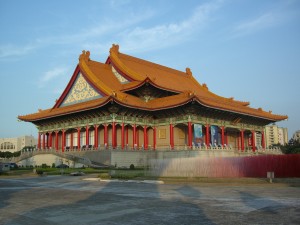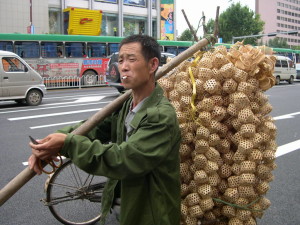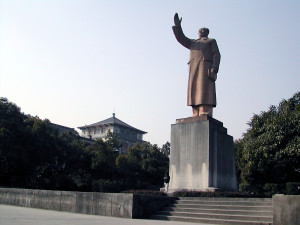Modern China and Its Economy
March, 2016
Beginning in the early 1970’s, President Richard Nixon and Secretary of State Henry Kissinger began to engage China, among other reasons, to involve it in world affairs and the world economy, in order to give China a reason to act differently (that is, more responsibly, or perhaps, more responsively to American interests,) in the international sphere, and to help China emerge from its relative isolation (from us,) of the revolutionary Máo years.
Since that time, and directly as a result of that policy (and, of course, China’s concurrence with it,) China has quickly become economically and politically important to the US. It seems to be on a trajectory to become even more important to and integrated with us and the world economy in years to come. The dynamism of the Chinese economy since 1978, and the apparent stability of the Chinese government during this period has astounded everyone in the West.
It must be noted that China now has the second largest economy in the world, after the US: it surpassed the former second largest economy (Japan) between 2008 and 2009, and by 2014 had reached about 10+ trillion dollars (US). (For reference, the US GDP in 2014 was about 17 trillion dollars and the world GDP was about 78 trillion dollars.)
In the 20th century, particularly the post-WW II period, the US was the ‘engine’ of the world’s economy. It is quite probable that we have already reached a tipping point where China now has an equal importance in the world economy (and this, within less than 40 years of China’s opening under Dèng Xiǎopíng and less than 10 years after its entry into the WTO!)
For about the past 25 years or so, China has absorbed huge amounts of the world’s investment capital: starting about 1993 China began to receive billions of US dollars per year in Foreign Direct Investment (FDI), to the point that a rather large chunk of the world’s investment capital now resides in China: by 2003 approximately 500 billion USD had been invested in China. Because of China’s favorable FDI policies, that investment and the number of Foreign-Invested Enterprises (FIEs) increased every year after China joined the WTO in 2001. (Potentially, at least, the total FDI amount could now be one and a half to two trillion US dollars: that’s a seriously large amount of FDI, even for a country of China’s size and population.)
Because of that, and also because of the presence in China of an almost inexhaustable pool (see ‘Lewis Turning Point,’ below) of willing and hard-working low-wage workers, it has reached the position of being a real manufacturing powerhouse. Since 1978, China’s economy has expanded more than tenfold …a rather amazing statistic. Growth on steroids!
This manufacturing powerhouse now absorbs all the (former) surplus of the world’s raw materials, and is a real competitor for those resources with us and the rest of the developed world. This is one of the reasons that prices for things like petroleum, copper, iron and other basic commodities and manufacturing resources were sky-rocketing all through 2007, until the Great Recession hit in 2008.
China reached the Lewis Turning Point (where its available pool of low-wage workers had all been absorbed into the manufacturing economy and become employed) by about 2003, when it began to experience labor shortages and rising wages. From that point, it became necessary for China’s leaders to point the Chinese economy in a new direction.
China now, under President Xí Jìnpíng, is trying to ‘turn the corner’ from being a manufacturing-based economy to becoming a consumer/hi-tech/creative/service economy. While economists differ about when, it is speculated that by 2025 or 2030 China’s economy may surpass the US economy in size. (At 10% annual growth an economy will double in size in about 7 1/2 years.) At the National People’s Congress meeting in early 2016, Premier Lǐ Kèqiáng announced a growth target averaging 6.5 to 7% for the 13th 5-year plan, and a goal of doubling the GDP and the per capita income from 2010 to 2020. Success in these goals would make achieving the ancillary target of becoming the largest economy in the mid-2020s likely.
Exactly when China’s economy overtakes the US economy in size will of course depend upon the future growth rates of the economies of both the US and China. As of 2015, China’s growth seems to have moderated from its former double-digit pace to somewhere between 4.5% (as estimated in the Western financial press) and 6.9% (as published in China.) Actual current statistics are generally hard to tease out of China, and often only become available years later. “Data disappears when it turns negative” is an often-heard comment made by Western China-watching economists. Current statistics that might reflect negatively on the Party’s performance are not generally issued by the Chinese government: statistics published in those situations are entirely suspect as propaganda.
It goes without saying that power-holders never want to give up their power, and that bureaucracies all share the same characteristic: they don’t like change …regardless whether their origins are revolutionary or otherwise.
The interesting contradiction in China today is that we are watching a national power structure trying to take power away from, or at least regulate and control, often corrupt provincial and local party structures to change from the command-economy that was to a more market-driven economy, while at the same time preserving their own power at the national level. Whether they can succeed at this is anybody’s guess. It should be noted, however, that they have been remarkably successful in their drive to modernize their economy thus far: more successful than almost everyone in the West expected, in this state-managed transition to market capitalism …or rather to what they call ‘Socialism with Chinese Characteristics,’ (actually, in terms of political economy, a form of state capitalism.)
 Quintessentially Traditional Chinese Architecture – The Concert Hall in Taipei’s CKS Park
Quintessentially Traditional Chinese Architecture – The Concert Hall in Taipei’s CKS Park
Economically speaking, the deficiency of China’s economic power is that it doesn’t yet have a developed demand-driven open market-oriented domestic economy that can utilize economies of scale to drive its future economic development. They still maintain a quasi-command economy, even though they have ‘loosened the reigns’ substantially in recent years, at least as far as outside investment is concerned, and they still support an enormous backlog of State Owned Enterprises (SOEs) into which they pour huge subsidies annually in the form of ‘loans’ from the People’s Bank of China… loans which are never repaid: an enormous waste of state assets.
In 2008, the SOEs held more than 30% of the assets of the Chinese economy, even though by number of companies, they were only a little more than 3% of the companies in China: huge in assets and employment, but small in absolute number of entities. There are presently still more than 150,000 SOEs, employing more than 35 million workers.
In September, 2015, the Central Committee of the CCP and the State Council indicated that it was their intention to reduce the number of SOEs substantially by moving to mixed state/private ownership of SOEs to better manage those state assets. SOEs would first be classified as either those that belong to ‘national security sectors’ (which would remain as they are, wholly state-owned and managed,) or others that have no national security aspect which could be better managed in a market-oriented mixed private/state ownership context run on a for-profit basis.
The difficulties of a maturing Chinese economy going forward are more fraught then before. In 1978, under Dèng Xiǎopíng, the problem of change was with a recalcitrant section of the Party that was locked into the old vision of what the CCP represented to the nation, whose members were subject to Party discipline. Now the problem is that changes in the economy to the SOEs represents a potential threat to social cohesion that could undermine the Party’s hold on power. The changes necessary to create the higher performing evolution of the Chinese economy point out a basic contradiction between the Party’s need for economic and political control, and the economy’s need for market mechanisms that run counter to that kind of control.
Most of the SOEs privatizations could result in large-scale failure of these companies and a resultant unemployment of millions. (Only very few privatized Chinese SOEs placed in a market context have survived in the past, but in the past, with the economy growing by double digits, there were plenty of new jobs with private companies in manufacturing to absorb the newly jobless.) Mistakes now could possibly result in massive unemployment in that section of the population upon which the power of the Party rests… the masses of the working population who have traded their political support for continuing economic advancement, and for which they hold the Party responsible.
Even without failures of privatized companies, the Chinese economy is undergoing some severe market displacements as a slowing economy and reduced sales force changes on the SOEs. Huge over-capacity and a backlog of over-production in the years of stimulus by the Party in the post-Great Recession period have led the SOEs to reduce their overhead and worker rosters through pay cuts, worker layoffs, worker hour reductions and withholding of benefit and pension payments (because they now lack the financial resources to make such payments).
These are only some of the actions that can, and have already created a more activist labor movement resulting in strikes at SOEs as well as worker attempts at organizing and public denunciations of Party attempts at counter-propaganda. Such labor actions are invariably met with strong police countermeasures including jailing of the leaders, often for years. (In the ‘worker’s paradise,’ workers only have the right to strike against private companies… not against the SOEs or the Party.)
At the same time, the Party has indicated that it will begin to take action against the huge over-capacity in the steel and coal industries that will lead to a reduction of at least 400,000 jobs in the steel industry and possibly a half million fewer jobs in the coal mining industry, as well. Such reductions if not carried out carefully could induce severe reactions, both among the affected workers, as well as in the functioning of the economy generally. Unfortunately, local and provincial level Party committees often keep mines and factories going even when unproductive, simply to avoid the social instability that mass unemployment would produce… and the Central Committee has yet to provide any solution to this conundrum.
It is in recognition of these facts that President Xí has been methodically securing his power base throughout the first years of his presidency, and centralizing his hold on the Party, the PLA, the Internet and media, the banking sector, in short, on all areas of the economy and of governance. In a slowing economy with uncertain results from never-before tried economic changes, he needs to make sure that any mistakes, if not minimized in fact, are minimized in the public’s perception, so as to avoid provoking reactions among the people that might threaten his and/or the Party’s rule.
Beginning in mid-2015 he also began centralizing all economic policy-making in his own hands, making the decisions about exchange rates, stock markets and other germane associated details, rather than leaving them in the hands of trained technocrats, as was formerly done under Presidents Hú Jǐntāo and Jiāng Zémín. The economic moves throughout the early 2000s now, in retrospect, seem both conservative and surefooted. At the time, however, Hú was accused of being slow to adapt. (How different things seem, now.)
While this certainly makes Xí more powerful, it also puts a personal stamp on both the policies and the results. And his inexperience with markets was visible for all to see in the Shanghai Stock Market bubble and bust of 2015/2016. After the Great Recession of 2008 the Government engaged in a huge stimulus policy to forestall serious economic problems in China. Because of a resultant steep rise in prices of real estate caused by this flood of cash, the Government then encouraged investment in the stock market to redirect the cash from the real estate sector, which resulted in a tripling of the Shanghai Market Index. Then, when the government unexpectedly depreciated the Yuan exchange-rate, the Shanghai Stock Market begin to drop like a stone. (The Government seemed not to understand that stock markets go both up and down.)
When some of the ‘market makers’ tried to get out of their positions before taking too much of a beating, the Party created rules prohibiting them from doing so, and implemented rules limiting the daily fall of a stock (called a ‘circuit breaker,’) which paradoxically gave speculators in the market a greater incentive to flee the stocks before trading was halted. Several individuals were charged with criminal violations, indicating the seriousness of the Party’s view on this matter. Ultimately, the chairman of the China Securities Regulatory Commission (CSRC), Xiāo Gāng, was forced to resign and take responsibility for the problems caused by the policy (thus shielding Xí from the onus of the mistakes).
What effect these mistakes will have on future policy-making is unknown, but will become apparent over time. Whether or not “Xí Dàdà” (as the propaganda organs have taken to calling him, and variously translated into English as either “Big Daddy” Xí or “Uncle” Xí) has learned anything about markets and managing them in a more free-market context, will also become apparent over time. It is also likely that what has been learned about managing markets in a less controlled context will also serve to inform everyone about how well or poorly China will do in overcoming the barriers the Party faces in its move into a more free-market type of economy, and whether or not it can actually be successful in overcoming those barriers.
© R. Teller, 2016
 An example of the traditional economy: a cricket-seller with hundreds of cricket cages in Kūnmíng, Yúnnán
An example of the traditional economy: a cricket-seller with hundreds of cricket cages in Kūnmíng, Yúnnán A statue of Máo Zédōng, the ‘Great Helmsman’ (wěi dà duò shǒu 偉大舵手/伟大舵手) on the campus of Hángzhōu University, Hángzhōu, Zhèjiāng.
A statue of Máo Zédōng, the ‘Great Helmsman’ (wěi dà duò shǒu 偉大舵手/伟大舵手) on the campus of Hángzhōu University, Hángzhōu, Zhèjiāng.
